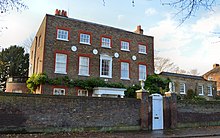
Beaufort House is an 18th-century grade II listed house in Ham, near Richmond, Surrey.

Beaufort House is an 18th-century grade II listed house in Ham, near Richmond, Surrey.
Beaufort House was built in about 1780. [1] It was originally the dower house to Ham House. [2]
In about 1855, a private Catholic girls school moved to Beaufort House. [3] In 1856, St Mary's Catholic Chapel was set up in its grounds, with a separate entrance for the public, and closed in 1870, when the school moved to Notting Hill. [1] [3]
The house was listed grade II in 1983. [4]
Lady Juliana Fermor Penn lived there until her death in 1801.[ citation needed ]
Admiral Sir William Parker, 1st Baronet, of Harburn died in 1802 at Beaufort House, which was his country estate when he was not living at 12 Crooms Hill, Greenwich. [5]
In 1901, Dr William Simpson Craig (1822-1893), the father of the psychiatrist Sir Maurice Craig and politician Norman Craig was living there, as was Norah Palmer Holroyd, an ancestor of Michael Holroyd. [6] From 1907 to 1920, Craig's son-in-law, Dr Macnamara (and his wife) lived there. [6]
The house is now home to Johnny Van Haeften, a British art dealer specialising in 16th and 17th century Dutch and Flemish Old Master paintings. Van Haeften now runs his business from a refurbished coach house in the grounds of Beaufort House. [7]

Dulwich Picture Gallery is an art gallery in Dulwich, South London. It opened to the public in 1817 and was designed by the Regency architect Sir John Soane by using an innovative and influential method of illumination. It is the oldest public art gallery in England and was made an independent charitable trust in 1994. Until then, the gallery was part of the College of God's Gift, a charitable foundation established by the actor, entrepreneur and philanthropist Edward Alleyn in the early 17th century. The acquisition of artworks by its founders and bequests from its many patrons resulted in Dulwich Picture Gallery housing one of the country's finest collections of Old Masters, especially rich in French, Italian and Spanish Baroque paintings, and in British portraits from the Tudor era to the 19th century.

Coombe is a place in the London Borough of Croydon, situated south-east of central Croydon, between Addiscombe, Selsdon and Upper Shirley. Formerly a hamlet, since the growth of suburban development the area has become swallowed into the London conurbation and often does not appear on modern map.
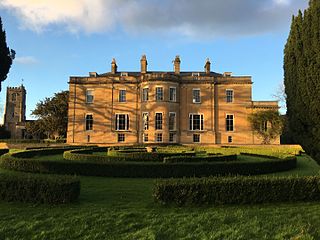
Dinder House, is a Somerset estate with a small country house Grade II Regency listed building in the village of Dinder, in the civil parish of St Cuthbert Out in Somerset. Dinder House was formerly a manor house dating back to the 12th century, but the existing building was constructed between 1799 and 1801 by the Rev William Somerville on the original site. The estate remained as the seat of the Somerville family until the late twentieth century.

Orsett Hall was a 17th-century Grade II listed building in Orsett, Essex. It was set in 12 acres (4.9 ha) of parkland and was the centre of the Orsett Hall agricultural estate. The house was destroyed by fire on 11 May 2007 and rebuilt in the same style and on the same footprint as the original building in 2009.
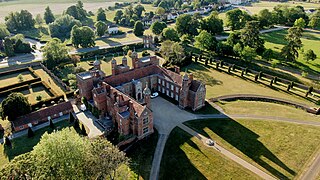
Melford Hall is a stately home in the village of Long Melford, Suffolk, England. Since 1786 it has been the seat of the Parker Baronets and is still lived in by the Hyde Parker family. Since 1960 it has been owned by the National Trust.

The Kymin, is a hill overlooking Monmouth, in Monmouthshire, Wales. It is located approximately one mile east of Monmouth, on the eastern side of the River Wye and adjacent to the border with the Forest of Dean and England. The summit of the hill, about 800 feet above sea level, is known for its neo-classical monuments, the Roundhouse and the Naval Temple, built between 1794 and 1800. It is registered on the Cadw/ICOMOS Register of Parks and Gardens of Special Historic Interest in Wales. The site is within a designated Area of Outstanding Natural Beauty (AONB) and is owned by the National Trust.

Ormeley Lodge is a Grade II* listed early 18th-century Georgian house, set in 6 acres (2 ha) on the edge of Ham Common, near to Richmond Park in Ham, London. It is owned by Lady Annabel Goldsmith.

Mary Somerset, Duchess of Beaufort also known by her other married name of Mary Seymour, Lady Beauchamp and her maiden name Mary Capell, was an English noblewoman, gardener and botanist. Among her introductions to British gardening are Pelargonium zonale, Ageratum species and Passiflora caerulea.

Doughty House is a large house on Richmond Hill in Richmond, London, England, built in the 18th century, with later additions. It has fine views down over the Thames, and both the house and gallery are Grade II listed buildings.

Esher Place is a Grade-II listed country house, since 1953 used as a college by the trade union Unite, in Esher, Surrey, United Kingdom. The building is at least the fourth on approximately the same site and mainly dates to the 1890s. It incorporates traces and small parts of some its earlier forebears.
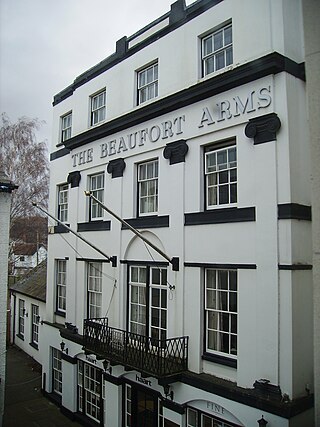
The Beaufort Arms Hotel, in Agincourt Square in the town of Monmouth, south-east Wales is a former coaching inn dating from the early eighteenth century. The frontage was modified in the 1830s, possibly by the prolific early Victorian architect George Vaughan Maddox. A stone cornice on the central block carries the inscription "The Beaufort Arms". A Grade II* listed building, it features in the Monmouth Heritage Trail. In the 20th century, the building was converted to residential apartments.

St Andrew's Church, Ham, is a Grade II listed Church of England church on Church Road, Ham Common in Ham in the London Borough of Richmond upon Thames.

Hill Street is a street in Mayfair, London, which runs south-west, then west, from Berkeley Square to Deanery Street, a short approach way from Park Lane. It was developed from farmland in the 18th century. Travelling one block to the east and south sees a fall of about three metres, whereas in the other direction the land rises gradually across six main blocks to beyond the north of Marble Arch. Hill Street's homes gained fashionable status from the outset: grand townhouses seeing use, at first, as seasonal lettings (rentals) and/or longer-term London homes of nobility — later, of other wealthy capitalists as much. Twenty-two, approximately half of its town houses, are listed. Along its course, only Audley Square House departs from townhouse-sized frontage, yet this shares in the street's predominant form of domestic architecture, Georgian neo-classical. Hill Street's public house is the oldest surviving one in Mayfair.
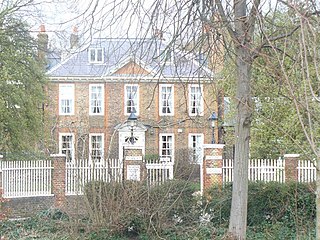
Douglas House is a Grade II* listed early 18th-century Queen Anne-style house in Petersham in the London Borough of Richmond upon Thames. It is now the site of the German School London.

Hare Street House is a Grade II* listed building in the hamlet of Hare Street that lies between Buntingford and Great Hormead in the East Hertfordshire district of Hertfordshire, England. It is mainly associated with the Roman Catholic priest and writer Robert Hugh Benson who owned the house from 1906 until his death in 1914.

The Chapel in the Wood is a chapel in the grounds of St Mary's University on Waldegrave Road in the Strawberry Hill part of Twickenham, London. The chapel is an example of early Gothic Revival architecture and is a Grade I listed building.

The Commander-in-Chief, Devonport, was a senior Royal Navy appointment first established in 1845. The office holder was the Port Admiral responsible for the command and administration of the Devonport Station. The appointment continued until 1900 when the Devonport Station was renamed back to the Plymouth Station and this title in name was abolished.

John Henry Van Haeften is a British art dealer, who specialises in 16th and 17th century Dutch and Flemish Old Master paintings. He has been a fanatical stamp collector from a young age, specialising in the stamps of Malta, and credits stamp collecting with enabling him to develop the eye for detail that he uses in his profession. He began his career at Christie's auction house which he joined at the age of 17 where he worked on the integration of the stamp dealers Robson Lowe into the firm. He subsequently transferred to their pictures department before starting his own gallery with his wife Sarah in 1977. He estimated in 2017 that he had sold 4,800 paintings during his career.

Head of a Bear is a drawing study made by Leonardo da Vinci circa 1480. It is small in scale, measuring only 7 by 7 centimetres, and is rendered in silverpoint pencil. It is thought to be part of a study of animals that Leonardo made in this period. The artist may have drawn upon this study when painting the head of the animal in his Lady with an Ermine of 1489–1490. The drawing was owned by the British painter Sir Thomas Lawrence in the 18th century and by the art collector Norman Colville in the early 20th century. The American billionaire Thomas Kaplan purchased the drawing in 2008. It sold in 2021 for a total of £8.8 million, a record for a drawing by Leonardo.